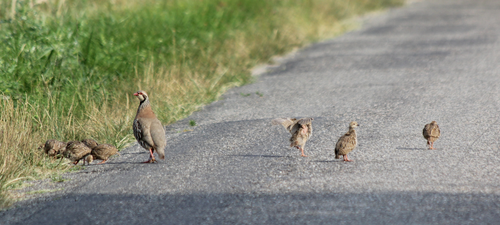
CORREIA Ricardo
- DBIO, University of Aveiro, Aveiro, Portugal
- Agroecology, Biodiversity, Climate change, Conservation biology, Habitat selection, Human impact, Landscape ecology, Species distributions, Terrestrial ecology
- recommender
Recommendation: 1
Reviews: 0
Recommendation: 1

Use of linear features by red-legged partridges in an intensive agricultural landscape: implications for landscape management in farmland
The importance of managing linear features in agricultural landscapes for farmland birds
Recommended by Ricardo Correia based on reviews by Matthew Grainger and 1 anonymous reviewerEuropean farmland bird populations continue declining at an alarming rate, and some species require urgent action to avoid their demise (Silva et al. 2024). While factors such as climate change and urbanization also play an important role in driving the decline of farmland bird populations, its main driver seems to be linked with agricultural intensification (Rigal et al. 2023). Besides increased pesticide and fertilizer use, agricultural intensification often results in the homogenization of agricultural landscapes through the removal of seminatural linear features such as hedgerows, field margins, and grassy strips that can be beneficial for biodiversity. These features may be particularly important during the breeding season, when breeding farmland birds can benefit from patches of denser vegetation to conceal nests and improve breeding success. It is both important and timely to understand how landscape management can help to address the ongoing decline of farmland birds by identifying specific actions that can boost breeding success.
Perrot et al. 2023 contribute to this effort by exploring how red-legged partridges use linear features in an intensive agricultural landscape during the breeding season. Through a combination of targeted fieldwork and GPS tracking, the authors highlight patterns in home range size and habitat selection that provide insights for landscape management. Specifically, their results suggest that birds have smaller range sizes in the vicinity of traffic routes and seminatural features structured by both herbaceous and woody cover. Furthermore, they show that breeding birds tend to choose linear elements with herbaceous cover whereas non-breeders prefer linear elements with woody cover, underlining the importance of accounting for the needs of both breeding and non-breeding birds. In particular, the authors stress the importance of providing additional vegetation elements such as hedges, grassy strips or embankments in order to increase landscape heterogeneity. These landscape elements are usually found in the vicinity of linear infrastructures such as roads and tracks, but it is important they are available also in separate areas to avoid the risk of bird collision and the authors provide specific recommendations towards this end. Overall, this is an important study with clear recommendations on how to improve landscape management for these farmland birds.
References
Perrot, C., Séranne, L., Berceaux, A., Noel, M., Arroyo, B., & Bacon, L. (2023) "Use of linear features by red-legged partridges in an intensive agricultural landscape: implications for landscape management in farmland." bioRxiv, ver. 2 peer-reviewed and recommended by Peer Community in Ecology.
https://doi.org/10.1101/2023.07.27.550774
Rigal, S., Dakos, V., Alonso, H., Auniņš, A., Benkő, Z., Brotons, L., ... & Devictor, V. (2023) "Farmland practices are driving bird population decline across Europe." Proceedings of the National Academy of Sciences 120.21: e2216573120.
https://doi.org/10.1073/pnas.2216573120
Silva, J. P., Gameiro, J., Valerio, F., & Marques, A. T. (2024) "Portugal's farmland bird crisis requires action." Science 383.6679: 157-157.
https://doi.org/10.1126/science.adn1390